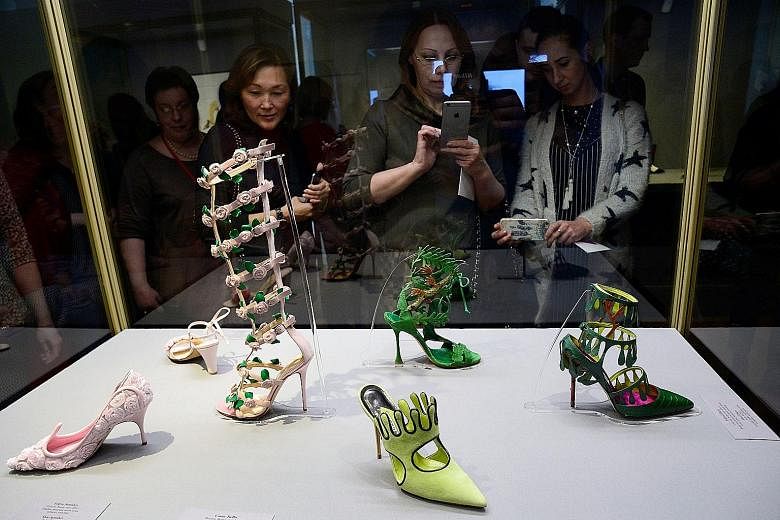NEW YORK • Who is walking the talk to buy shoes and stepping off to the nearest shop?
For sure, the Sex And The City stereotype of the shoe enthusiast as a fashionista with a passion for high heels is seriously out of date.
Today's shoe collector is probably buying sneakers and is quite likely male.
Shoes may have as much glamour as ever, but they are not the kind high-end maker Christian Louboutin would recognise.
If current trends continue, men's shoe sales in the United States will soon surpass women's.
At US$26.2 billion (S$36.3 billion) last year versus US$29.9 billion for women's footwear, "men's is closer in size to women's than it's ever been", said Ms Beth Goldstein, fashion footwear and accessories analyst at the NPD Group.
Women's sales are shrinking as men's continue to rise, in both revenue and number of pairs sold.
Behind the sales figures is a cultural shift.
As dressing becomes more casual, habits are converging, with women buying more versatile styles and men expanding their shoe collections.
Traditionally, men got more wear out of any given pair of shoes.
"If you're getting a pair of desert boots or brogues, you can wear those every day, all day, all year," said Andrew Luecke, a New Yorkbased menswear writer and coauthor of new book Cool: Style, Sound And Subversion.
"A pair of Louboutin stilettos? Not so wearable."
So instead of picking up sandals in the spring and boots in the fall, women are now buying shoes they can wear year-round, such as ankle boots and sneakers.
Their purchase patterns now look more like men's. That is bad news for retailers which count on seasonal lines to drive purchases.
Meanwhile, the rise of sneakers as all-occasion footwear is encouraging men to build their wardrobes while depressing women's sales.
"Men have the tendency to collect things," observed Luecke. "Once, it was baseball cards. Now, it's sneakers. If you're collecting, you can't have too many sneakers."
And if you are not into sneakers, you can buy shoes to go with your favourite pastime - camping, fishing, rockclimbing, snowshoeing, whatever.
They are not frivolous fashion; they are serious gear.
For women, however, less formal footwear means fewer purchases.
If you are sneaker shopping, you do not have to buy several pairs to find one that feels comfortable after more than a short stroll on the shoe department carpet.
Instead of closets full of barely worn rejects, women can build smaller wardrobes of shoes they actually wear.
Women could, in theory, stock up on sneaker styles. But shoe companies do not make it easy.
"Why should women's colour ranges be limited to pinks, purples and pastels?" lamented sneaker lover Anna Bediones in a 2013 article.
Others have wondered the same thing whenever they venture into a sneaker store: Why are the styles they like only on the men's side? Why can women not get goodlooking shoes? It is a role reversal.
Although women's offerings have become a bit better in recent years, petite sneaker lovers such as Ms Bediones still resort to the kids' department to get the styles they want.
Women with larger feet buy men's sneakers, so at least some of the growth in "men's footwear" is sales to women.
Less-determined shoppers simply hold on to their money.
After all, no one needs dozens of pairs of shoes.
The bottom line is that people buy shoes because they move imaginations - with their beauty, novelty, comfort or associations. Shoes promise to transform people. That promise is what makes them glamorous - whether Manolo Blahniks or Air Jordans.
"They're architectural," said Luecke. "There's something powerful and special in that.
"Plus, they're the one part of your outfit you get to check out all day: 'I'm wearing cool shoes. I feel cool.' It's transformative."
That feeling has driven many to a purchase of beautiful, impractical stilettos. To recapture female customers, retailers need merchandise which offers the same sensation in less formal styles.
As men already know, shoes do not have to hurt to be glamorous.
They just have to make you feel special.
BLOOMBERG

